Saturdays, noon to 1 p.m. ET on WICR 88.7 FM.
Or listen live from anywhere on WICR Online!
Our call-in number during the show: (317) 788-3314

December 8, 2018
Iconic signs across Indiana
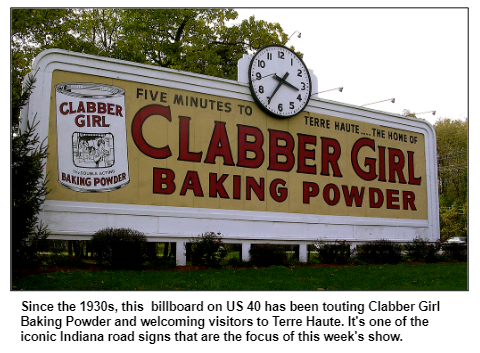

Since the 1930s, a billboard on US 40 as motorists approach Terre Haute has been touting Clabber Girl Baking Powder and welcoming visitors to the city, which, the sign notes, lies five minutes ahead. The billboard - among the oldest in Indiana - is temporarily down for restoration work by Rose-Hulman Institute of Technology, which has purchased the sign and surrounding property from the Hulman family of Terre Haute. Founded in 1899 by the family of Terre Haute business and civic leader Tony Hulman, Clabber Girl Corp. erected roadside billboards during the 1930s to help make the brand a household name.
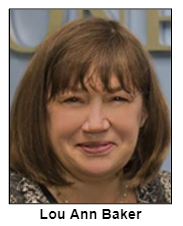
- Lou Ann Baker, public relations director for OneAmerica, the life insurance, retirement and employee benefits company. It has received more than 10,000 suggestions during 60 years of signboard puns and wordplay; those that make it to the signboard range from humorous and witty to downright groan-worthy. Another example: "I'd rather check my Facebook than face my checkbook."
- And Steve Brady, vice president of advancement at Rose-Hulman. Rose-Hulman has hired a Terre Haute-based artist to restore the Clabber Girl billboard, which is 44 feet long and features a large electric clock. According to Rose-Hulman officials, the vintage sign was one of the first electric billboards in the country.
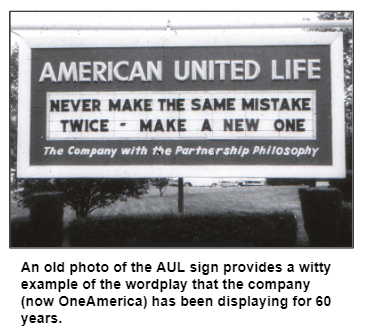
The signboard tradition at then-AUL began when the company was headquartered in a building on Fall Creek Parkway on the near-northside of Indy. According to the company, the first signboard apologized to motorists for inconveniences caused by construction of the headquarters building. An early signboard pun dealt with safe driving: "Avoid that rundown feeling - Obey stop signs."
During the subsequent 60 years, some of the signboard's messages have been era-specific. "If you eat like a piggy - You won't be a Twiggy" was a message on the signboard during the 1960s, when English fashion model Twiggy, known for her slender shape, was a household name.
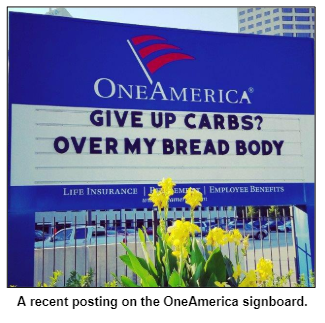
To share details about the sign in Colfax still touting the long-closed catfish restaurant, correspondent Phil Brooks, a Hoosier History Live listener based in Brownsburg, will call in during the show. Phil will explain who has been paying the electric bill all of these years for the illuminated sign. He also will report on other landmark signs across the state.
For the Clabber Girl billboard, which had deteriorated, Rose-Hulman has hired an artist from the Terre Haute area to do the painting portion of the restoration work. The project also involves improving the billboard's wooden frame, the mechanics of the clock and other features. Rose-Hulman took ownership of the historic sign and surrounding property as part of the purchase in 2017 of more than 1,100 acres from the Hulmans.
During our show, listeners will be invited to call in and describe their favorite iconic signs across Indiana. The WICR-FM studio's phone number is 317-788-3314.
Roadtrip: Fairbanks Art & Natures Park - "100 Acres"
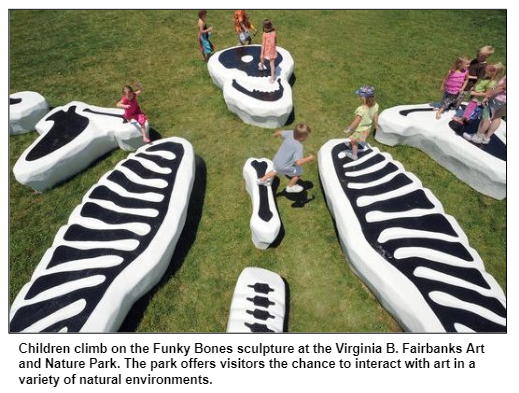
Guest Roadtripper Terri Gorney of Fort Wayne is vice president of Friends of the Limberlost and also a Master Gardener. Terri suggests a visit to the Virginia B. Fairbanks Art and Nature Park at Newfields (formerly known as the Indianapolis Museum of Art) on the northside of Indianapolis.
The Art and Nature Park is one of the largest museum art parks in the country and the only one to feature the ongoing commission of site-responsive artworks by artists from around the world.
With much of its perimeter defined by a bend of the White River, the park encapsulates a spectrum of natural environments, including wetlands, woods, meadow and a 35 acre lake.
Scattered among the natural beauty of the park are sculptures that create moods from whimsical to contemplative. Favorites include Funky Bones, a giant skeleton lying on the ground that invites kids (and young-at-heart adults) to engage in some playful climbing. Park of Laments draws visitors through a long, enclosed tunnel to enter a castle-like courtyard enclosed by stone basket walls.
Located on 38th Street just west of the museum, the park is free and open to the public. Visitors can enter the park from its parking lot at 1850 W. 38th St.; Newfields members can park at the museum and gain access via the pathway leading down over the canal.
Terri says the Art and Nature Park is a great place to get away from it all, right in the heart of Indianapolis. Whatever the season or weather, this is a great place to get your nature on!
History Mystery
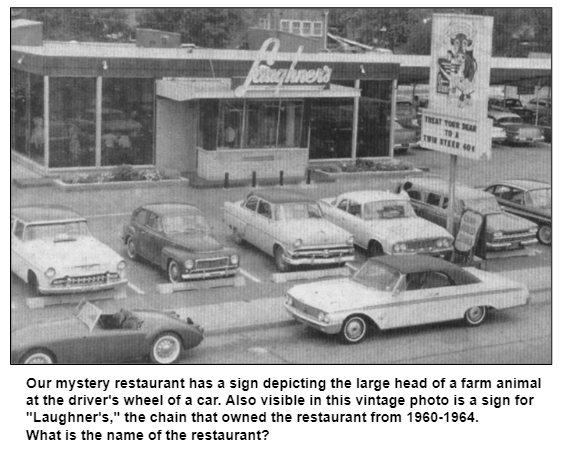
A restaurant that's been open on the eastside of Indianapolis for nearly 60 years has a distinctive sign. The sign depicts the large head of a farm animal at the driver's wheel of a car. During the 1960s and '70s, the restaurant primarily was known as a drive-in. Although drive-through service is still available today, the indoor dining area is the busiest aspect of the historic eatery.
Its sign with the farm animal and the car is a riff on the name of the eastside Indy restaurant.
Question: What is the historic restaurant's name?
Please do not call in to the show until you hear Nelson pose the question on the air, and please do not try to win if you have won any other prize on WICR during the last two months. You must be willing to give your first name to our engineer, you must answer the question correctly on the air and you must be willing to give your mailing address to our engineer so we can mail the prize pack to you. The prizes this week are a gift certificate to Calvin Fletcher's Coffee Company in Fountain Square, courtesy of Calvin Fletcher's, and four tickets to the Indiana History Center, courtesy of the Indiana Historical Society.
Prizes sought for History Mystery
Want to reach thousands of sophisticated, intelligent Hoosier History Live listeners?
If your business or organization would like to contribute prizes for our History Mystery question, please email molly@hoosierhistorylive.org or give her a call at (317) 927-9101.
We love prizes that can easily fit in a business envelope, such as tickets or vouchers. Your business or organization gets a mention on the air by our host, as well as a mention and link in this newsletter and on our website.
Nelson Price, host and historian
Molly Head, producer/project manager, (317) 927-9101
Michael Armbruster, associate producer
Cheryl Lamb, administrative manager
Richard Sullivan, senior tech consultant
Pam Fraizer, graphic designer
Garry Chilluffo, special events consultant
Please tell our sponsors that you appreciate their support!

 Acknowledgments to Monomedia, Visit Indy, WICR-FM, Fraizer Designs, Heritage Photo & Research Services, Henri Pensis, Chris Shoulders, Aaron Duvall, and many other individuals and organizations. We are an independently produced program and are self-supporting through organizational sponsorship, and by individual contribution at the yellow button on our newsletter or website. For organizational sponsorship, which includes logos, links, and credits in the show, contact Molly Head at (317) 927-9101 or email her at molly@hoosierhistorylive.org. And any of our podcasts can be sponsored for a nominal fee.
Acknowledgments to Monomedia, Visit Indy, WICR-FM, Fraizer Designs, Heritage Photo & Research Services, Henri Pensis, Chris Shoulders, Aaron Duvall, and many other individuals and organizations. We are an independently produced program and are self-supporting through organizational sponsorship, and by individual contribution at the yellow button on our newsletter or website. For organizational sponsorship, which includes logos, links, and credits in the show, contact Molly Head at (317) 927-9101 or email her at molly@hoosierhistorylive.org. And any of our podcasts can be sponsored for a nominal fee.
Thank you!
We'd like to thank the following recent, new and renewal contributors whose donations help make this show possible!
- Kathleen Angelone
- Stacia Gorge
- Teresa Baer
- Linda Gugin and Jim St. Clair
- Tom and Linda Castaldi
- Jinsie Bingham
- James H. Madison
December 15, 2018 - coming up
Town history of Santa Claus, Ind., and children's letters
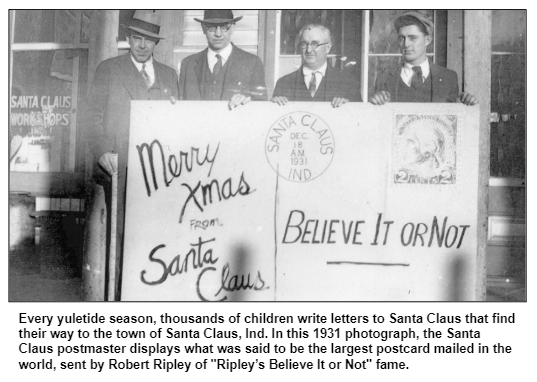
Since the mid-1800s, a Spencer County town located in far-southwestern Indiana has been named Santa Claus.
The town's post office is the only one in the world with the Santa Claus name, according to the Indiana Historical Society. Every yuletide season, thousands of children write letters to Santa that find their way to the town. Letters are answered by community volunteers - known as as "elves" - at the Santa Claus Museum & Village, which opened within the town in 2006.
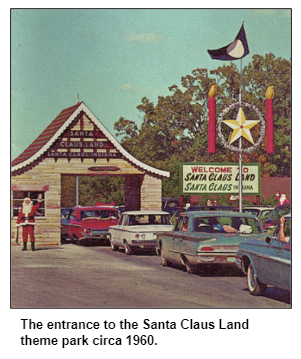
The town itself was platted in 1846 and originally called Santa Fe, according to the historical society. When the town sought to establish a post office, the request was denied because a town named Santa Fe already had been established elsewhere in Indiana. So Spencer County residents agreed to change the town name to Santa Claus; in 1856, the U.S. Postal Service approved the application for its post office.
Mrs. Koch, 87, grew up in the area. Her father, Jim Yellig, was the long-time Santa Claus at the Santa Claus Land theme park that opened in 1946. Today, the expanded theme park has broadened its focus and is known as Holiday World and Splashin' Safari.
At the Santa Claus Museum, the "village" includes a statue of Santa Claus that's 22 feet tall. The historic church, which was built in 1889, is open for tours. In 2014, the hard-working "elves" responded to more than 24,000 letters. In addition to being sent from across the United States, letters are written by children in Germany, Japan, France and elsewhere overseas.
© 2018 Hoosier History Live. All rights reserved.
|




